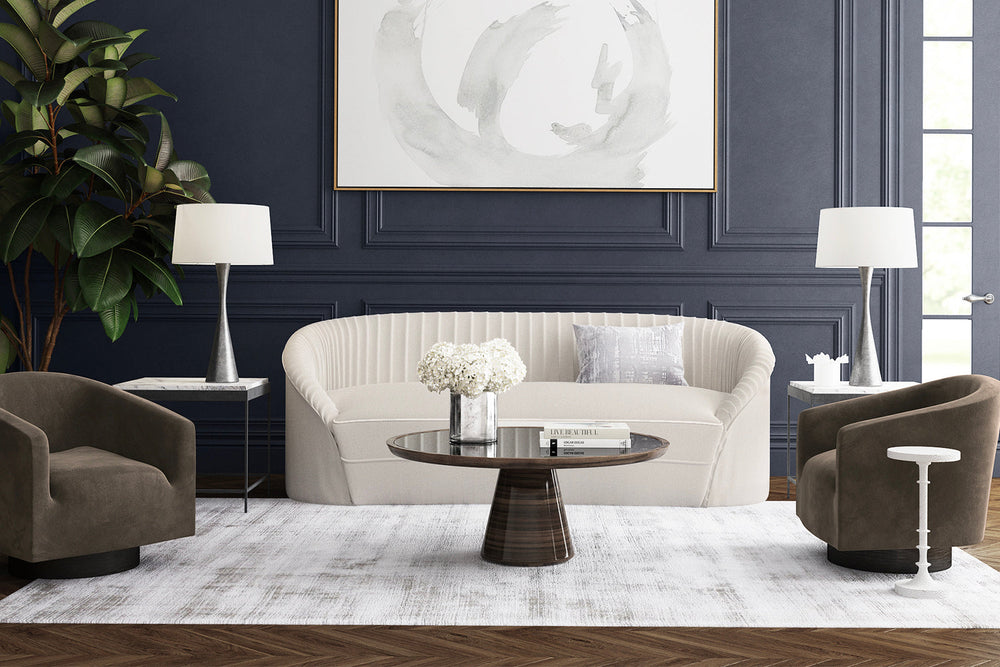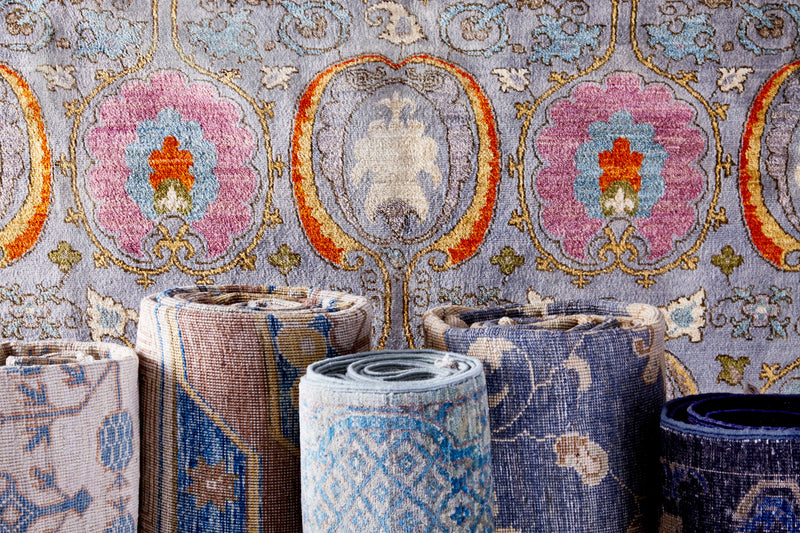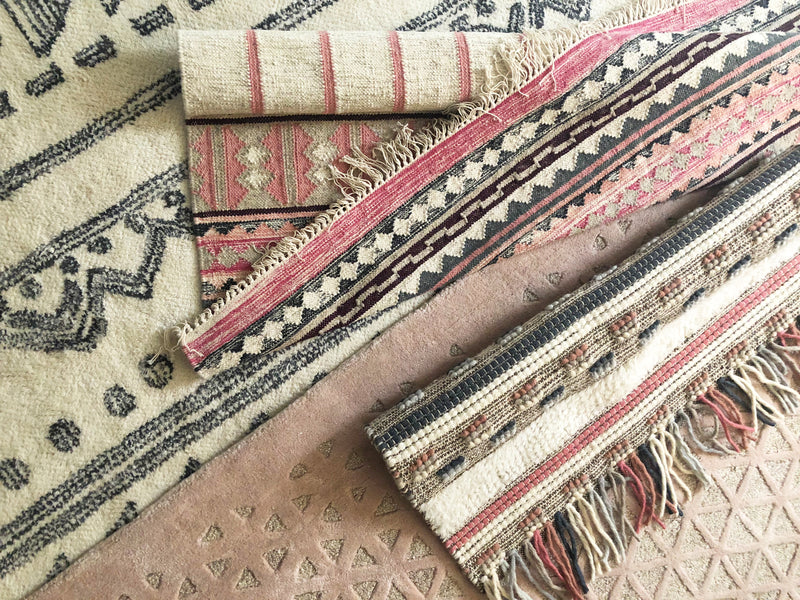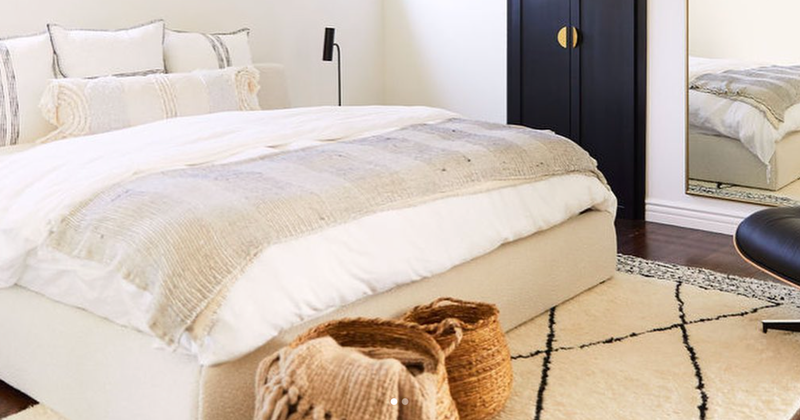
When decorating a home, a rug is a statement piece that can pull all of the elements together...or make a room feel strangely not-quite-right. A well-positioned rug can help define a living area and add depth and warmth to a space. But an overly large rug can envelop a room and a too-small runner can make an otherwise lovely hallway feel oddly cramped... basically, finding the right size rug for your space can be a challenge.
Rugs are a fantastic design element for breathing new life into your surroundings. From the initial spark ignited by a mesmerizing pattern or hue, the quest for the perfect size rug unfolds.
To simplify the rug buying process envision your rug as a choreographed partner to your furniture, effortlessly optimizing the opulence of your space. Our rug size guide serves as your exclusive pass to graceful grandeur, offering our expert tips on selecting the right dimensions for various spaces in your home. Embark on this design journey and let the magic unfold!
Living Room
What rug size do you need for your living room? Regardless of your room's dimensions, you can determine the ideal rug size by considering the placement of your furniture. Enhance the warmth and welcoming atmosphere of your living space with one of the options below.
The living room rug gets the most attention. Be sure to pick a rug that suits the size and needs of the room. For instance, if you’re decorating a beachside cottage, you don’t want to pick a heavy rug that you can’t get sand out of. But if you're in a mountain cabin, a plush wool rug can add texture and coziness to the home.
Since the living room rug also gets the most wear, you'll want to pick a rug that’s not too thin or fragile. A rug that’s constantly rolling up at the edges or buckling in the middle will add an unnecessary annoyance to your life.
To pick a size, we recommend a two-foot rule (keep the rug two feet away from the walls or edge of the space). Another good rule of thumb: a rug should be anchored by the front two feet of your couch and chairs.
So, your coffee table should have all four feet on the rug, then the couch and chairs will have their front two feet anchoring the sides. If the furniture fits on the rug comfortably in this configuration, your rug is the right size and won’t risk overwhelming (or underwhelming) the room.
Typically, an 8’ x 10’ rug works for most living rooms. For living rooms smaller than 11’ x 13’, try a 6’ x 9’ rug. Unless your living room is very small, avoid a 5’ x 8’ rug for the space. It often ends up simply floating beneath the coffee table, which ends up making the space look smaller. For a quick look at all these numbers, check out our rug sizes chart.
First Option
For this layout below, all furniture legs sit on top of the rug. This approach is perfect for harmonizing mid-sized or larger spaces and open-concept designs, and it can also be effective in smaller rooms. Arrange your furniture according to your style and room layout. Then, measure around the perimeter of the furniture pieces, keeping in mind to leave approximately 6-18 inches of space between the rug and the walls.

Second Option
In this arrangement, the front legs of your chairs and sofa are on top of the rug, while the back legs remain on the bare floor. Accent pieces are not required to be placed on the rug. This setup is best for smaller spaces or when furniture is placed against the wall. Remember, keep the rug two feet away from the walls or edge of the space. A rug arranged in this manner serves to anchor your furniture and contributes to a visually balanced room.

With either of these rug arrangement options the rug should be 6-8 inches wider than your sofa on both sides of the arms. Be sure to note your end tables.

Bedroom
Adding rugs to the bedroom instantly introduces a delightful and cozy ambiance. Since the bed serves as the focal point, it should guide you in determining the placement of the rug. Whether you have a queen or king-size bed, measure to ensure the rug extends beyond the sides of the bed.
Another component to consider when finding the best rug size is this: Where would you be barefoot the most? Rugs add style to a room, but they also add comfort, which might be the most important thing when it comes to the bedroom.
For bedrooms, you’re very often barefoot around the sides and end of your bed, so that’s the exact space your rug should cover. Our recommendation is at least 18-24 inches past both the foot and each side of the bed. This arrangement offers multiple benefits: it beautifully frames your bed, eliminates tripping hazards, and provides a soft landing underfoot when you wake up.
Rug Size for King Bed
The rug should cover at least 2 feet around the bed and extend out to the ends of your nightstands. Ideally, the rug will reach to the far end of the nightstands, but if it stops at around the halfway point of your bedside tables, that will also look fine. Usually, a 9’ x 12’ rug works great for a king bed.
Rug Size for Queen Bed
For a queen bed, it’s still best for the rug to reach from under the bed all the way to the near edge (the edge closer to the bed) of your nightstands. The rug should also extend out from the foot of the bed by 2-3 feet. An 8’ x 10’ rug would give great coverage for a queen bed, though you could get away with using a 6’ x 9’ if you don’t mind a little more exposed flooring.
First Option
For this layout below, all furniture legs sit on top of the rug. This approach is perfect for harmonizing mid-sized or larger spaces. You'll want to make sure all nightstand legs are included on the rug to avoid nightstand wobbles.
Second Option
For this layout below, the bed and nightstands remain on floor space. The rug begins at the base of the nightstand and extends towards the foot of the bed.
With either of these rug arrangement options the rug should extend out from the foot of the bed by 2-3 feet with or without a bench.

Dining Room
Just as the bedroom rug size is dictated by the size of the bed, the dining room rug is determined by the size of the table. Our advice is to have the rug wide enough that the chairs can easily move. If a dining room rug is too small, the chair will catch the edge of the rug. We suggest the rug is large enough for the chairs to move in and out without any problems.
An 8’ x 10’ rug works well for most dining rooms. If you have a very large room and dining table with eight or more chairs, a 9’ x 12’ might be more appropriate. Or if you have a four-seater and a cozier space, a 6’ x 9’ might do nicely.
To ensure sufficient space for your chairs, measure 3-4 feet from the edge of your table, outward. We suggest pulling out your chairs during the rug measurement process as a useful method to visualize the final outcome and proper dimensions.

Due to potential food & drink spills we recommend our performance rugs for your dining area.

Hallways
Runners are the long, narrow rugs typically found in hallways. We recommend letting the runner match the shape of the hallway, but it doesn’t need to match the length as exactly. However, here's a case where shorter is definitely better than longer: be sure that the rug doesn’t extend into the entryway, where it would make the room feel uneven. For hallway width, we suggest leaving 3-5 inches of floor space on each side of the rug. However, with narrower hallways, you can leave just 2-3 inches of hardwood floor showing without making your hallway feel cramped. Our number one rule: be sure the runner is centered.
Although hallways are the most popular place for runners, you could use a runner rug on either side of your bed (if you’d like an alternative for a large bedroom rug). Small runners can also be used in the kitchen or the bathroom, typically under sinks.
Runners also get a lot of wear, so pick something reasonably sturdy that won’t slip or slide around on your floor. Runners are also great in noisy households as they can dampen sound in hallways, and give smaller areas a bit of extra personality. An often more-affordable rug, runners are an excellent way to show off a vintage find, or protect your hardwood flooring from a high-traffic area.

Most runners will need to be custom ordered to fit your hallway measurements.

What to consider when determining the right size of your rug
DOORS
Will each door have enough space to swing over the rug without catching? If not, consider a rug with a shorter pile height.
WALLS
We recommend leaving enough space between the rug and the wall. Regardless of the room type, plan for at least 3-6 inches of space from rug edges and the walls.
FLOOR GRATES
Your rug cannot cover any grates in the floor for safety reasons. Leave at least 1 inch from grates as well as radiators.
PATHWAYS
Take into consideration common pathways in your home. Avoid allowing rug edges to become tripping hazards.

How to take correct measurements for a custom-sized rug
To begin measuring, gather these two tools:
- Measuring tape
- Blue painter's tape
- First, finalize your furniture placement.
- Start measuring using the information from this rug size guide.
- Use the painter's tape to create a mock-up of the rug. You can either do the entire perimeter of your soon-to-be rug or just the corners.
- Contact us for further information.

The right way to rug
Purchasing a new rug for your home is a big step. The advantage of ordering a custom-sized rug is the ability to tailor the fit precisely to your home. With these guidelines, you're well on your way.
All LOOMY rugs are available in industry-standard sizes such as 8'x10', 9x12', and more. Additionally, we provide the option for custom sizes tailored down to the inch.
Now, happy rug hunting...








